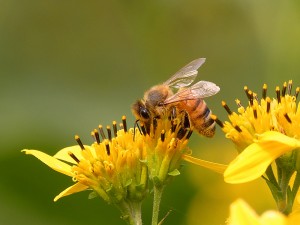12
Aug
Pesticides Registered by EPA Alter Honey Bee Microbiome
(Beyond Pesticides, August 12, 2016) A new study by a team of scientists at Virginia Tech finds that commonly used in-hive pesticides result in changes to the honey bee gut microbiome. The study, Honey bee gut microbiome is altered by in-hive pesticide exposures, was led by Virginia Tech associate professor of horticulture, Mark Williams, Ph.D., and colleagues from Oregon State University and North Carolina State University. This research, published several weeks ago in the journal Frontiers in Microbiology, aimed to determine the microbiome of honey bees (Apis mellifera) after being exposed to three common pesticides. Coumaphos and tau-fluvalinate, both common miticides used in conventional beekeeping, and chlorothalonil, a fungicide commonly detected in hives, were used as pesticide treatments in the study.
While this research contributes to the already established body of science on the complexity of pesticide exposure effects, beekeepers reported the steepest, and then sustained, declines in honey bee populations after the large increase in neonicotinoid pesticide use in the early 2000’s. Beekeepers nationwide suffered their highest hive losses of 44.1% in the last national survey from April 2015-2016. While it is likely that neonicotinoids are not the sole factor in pollinator decline, they have been found to exacerbate other challenges that pollinators face, such as the one reported in the Virginia Tech research. Neonicotinoids weaken the immune system of honey bees, making them more likely to succumb to disease carried by varroa mites and other parasites. Multiple studies have found that bees exposed to neonicotinoids have more parasite and pathogen problems, increasing the need for the mite pesticides evaluated in the Virginia Tech research.
Dr. Williams told Science Daily that, “Although helpful for ridding hives of parasites and pathogens, the chemicals in beekeeper-applied pesticides can be harmful to the bees. Our research suggests that pesticides could specifically impact the microbes that are crucial to honey bee nutrition and health.” This is especially alarming because changes to the gut’s microbiome can lead to difficulty metabolizing sugars and peptides, which is vital to honey bee health and immune system response.
This field-based study used three pesticides, along with a pesticide-free control at three replicated treatment sites in Montgomery County, Virginia. The microbiome of the honey bees at each location was assessed in relation to the control after a 6-week pesticide treatment. The analysis reveals that cholorothalonil-treated hives show the most significant changes to the structure and function of the honey bee gut bacteria relative to the control. The dominant bacteria present in the honey bees studied were Firmicutes, Actinobacteria and Proteobacteria, which is consistent with previous studies looking at the bee bacterial community. There was little evidence on any changes to the fungal communities of the honey bees from pesticide exposure after the treatments.
Chlorothalonil, a broad-spectrum fungicide originally registered in 1966 by the Diamond Shamrock Corp. is widely used on field crops, as well as peanuts, vegetables and fruits. The U.S. Environmental Protection Agency (EPA) characterizes chlorothalonil as “relatively non-toxic” to honey bees, but identifies it as a “probable human carcinogen.” However, EPA does not require data on the effect of this pesticide on human or non-target organism gut health, which is just one of the holes in the data required for registration. There has been limited examination of the mechanisms involved with miticides and fungicides and declining honey bee health. A 2013 study found that fungicides, chlorothalonil in particular, rendered honey bees more vulnerable to gut parasites such as Nosema ceranae.
The research team hopes to continue investigating the specific changes in the honey bee gut microbiome using data to “help best characterize the microbes that support healthy honey bees and thus stave off disease naturally.” While researchers say further studies are needed, pesticides have consistently been implicated as a key issue in pollinator declines, not only through immediate bee deaths, but also through sublethal exposure causing changes in bee reproduction, navigation and foraging. Beyond Pesticides has comprehensively compiled research that highlights the impact of various pesticides on these organisms and their role in exacerbating susceptibility to parasites and viruses.
This critical research comes at a time when pollinators, specifically honey bees, are gaining national attention due to their importance for pollinator services and their continued decline. Despite the delayed action by federal agencies and Congress to discontinue the use of neonicotinoid insecticides and synthetic pesticides in general, consumers and advocates around the country can create safe pollinator habitat and encourage local governments to do the same. Use the Bee Protective Habitat Guide to plant a pollinator garden suited for your region, and consider seeding white clover into your lawn. You can also declare your garden, yard, park or other space as pesticide-free and pollinator friendly. Sign the pledge today!
Source: Science Daily, Virginia Tech News
All unattributed positions and opinions in this piece are those of Beyond Pesticides.










